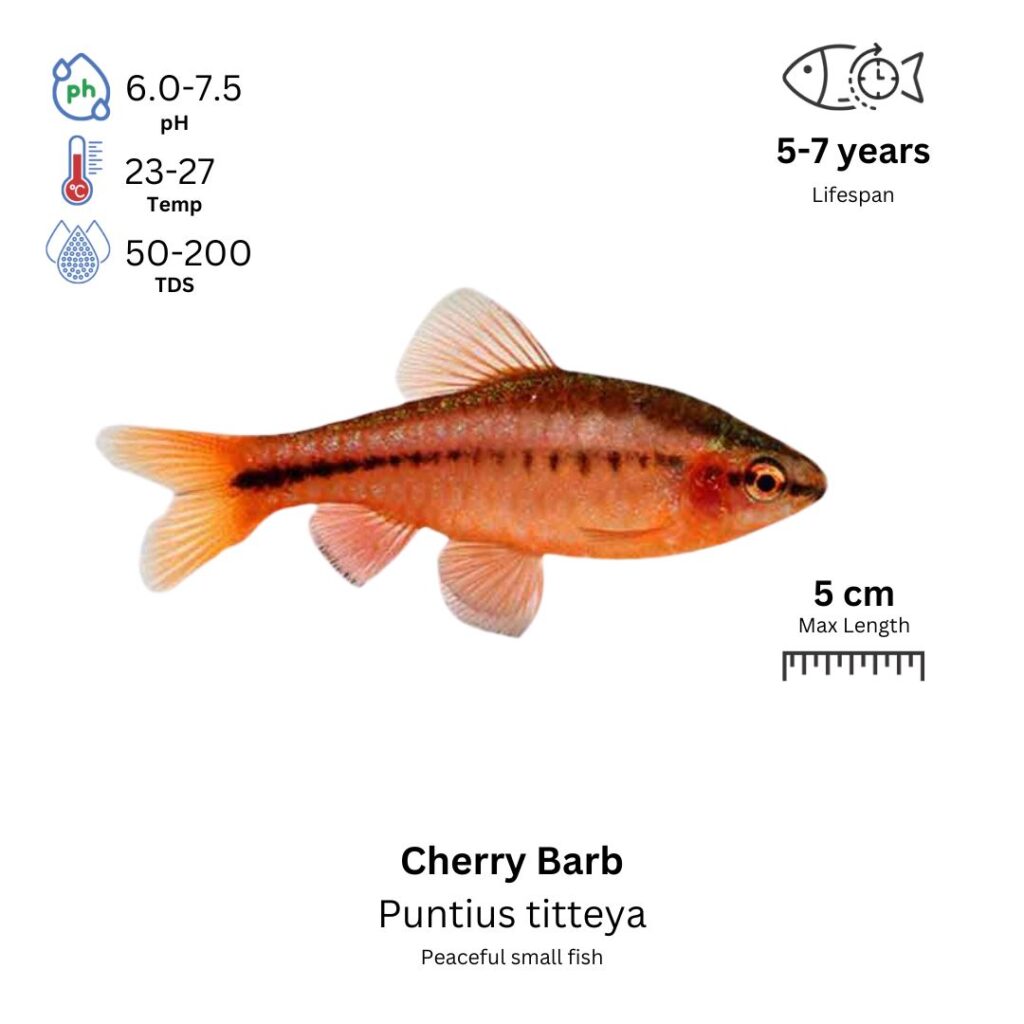Cherry Barb
Puntius titteya

Description
The Cherry Barb is a small and vibrant freshwater fish known for its striking red coloration. Males are particularly colorful, displaying a bright red body that intensifies during the breeding season, while females are usually more subdued in color, with a more transparent or yellowish hue. They have an elongated, streamlined body with a distinct black line running along their midsection, and their fins are typically transparent with a slight reddish tint. Cherry Barbs are peaceful, active fish that thrive in groups and are best kept in schools. Their vibrant color and peaceful nature make them ideal for community aquariums.
Habitat Origin
Native to Sri Lanka, where they are found in slow-moving rivers, streams, and ponds with dense vegetation. They thrive in warm, clear waters with moderate water flow.
Aquarium
Ideal Number in Aquarium: At least 6 individuals, as they are schooling fish and feel more secure in groups.
Favorite Food

Cherry Barbs are omnivores and will accept a variety of foods, including high-quality flake food, micro pellets, and live or frozen foods like brine shrimp, bloodworms, and daphnia. They also enjoy some plant matter, such as algae or blanched vegetables, making them suitable for planted tanks.
Behavior:
Cherry Barbs are peaceful, active, and social fish. They are most comfortable when kept in schools, where their natural behavior and vibrant coloration are most evident. While they are active swimmers, they are generally not aggressive and do well in community setups with other small, peaceful species. During the breeding season, males become more intensely red, and their natural color is most vivid when kept in groups. They are not fin-nippers and generally get along with other species in a peaceful aquarium setup.
Special Care:
Cherry Barbs thrive in well-planted tanks with plenty of hiding spots, such as plants, driftwood, and rocks. Regular water changes and good filtration are essential to maintain water quality, as they are sensitive to poor water conditions. A gentle water flow is ideal, as they are used to slow-moving waters in their native habitat. Cherry Barbs are fairly hardy but do best in stable conditions.
Compatibility with Other Fish:
Yes, Cherry Barbs are compatible with other peaceful fish such as tetras, rasboras, small catfish, and shrimp. They are non-aggressive and can coexist with a variety of small to medium-sized fish that share similar water requirements. However, avoid keeping them with larger, aggressive species that may intimidate or harm them. Their peaceful nature and schooling behavior make them ideal for community tanks.
Breeding Tank Setup
A dedicated breeding tank is highly recommended for Cherry Barbs to protect the eggs and allow better control of environmental factors. A 10-gallon (38-liter) tank is suitable for a breeding pair or small group, while a 20-gallon (75-liter) tank is better for multiple pairs. Maintain a pH of 6.0–7.5, temperature of 24–28°C (75–82°F), and hardness of 5–12 dGH. Use fine gravel or sand substrate, and decorate the tank with live plants like Java moss or Anubias for egg-laying and shelter. A gentle sponge filter will maintain water quality without disturbing the fish, and moderate lighting on a 12-hour cycle is ideal.
Conditioning for Breeding
To prepare Cherry Barbs for spawning, offer a nutritious, varied diet. Feed them high-quality flakes or micro pellets, supplemented with live or frozen foods such as brine shrimp, bloodworms, and daphnia. Add vegetable matter like chopped spinach or peas to support overall health. Perform weekly 20–30% water changes to keep the water clean. To stimulate spawning, execute a larger water change (around 50%) and raise the temperature slightly to 28°C (82°F), simulating seasonal rains.
Spawning Behavior
Spawning usually occurs in the morning or shortly after a water change. Males become more intensely red and chase females, encouraging them to scatter 30–50 sticky eggs among plants and decor. These eggs quickly adhere to surfaces like plant leaves, gravel, or even glass. Because Cherry Barbs may consume their own eggs or fry, it’s essential to remove the adults immediately after spawning to improve hatching success.
Fry Hatching & Care
Eggs hatch within 2–3 days, depending on the water temperature. Newly hatched fry will consume their yolk sacs for nourishment for the first few days. After that, begin feeding with infusoria or liquid fry food, transitioning to baby brine shrimp, microworms, or finely crushed flakes as they grow. Perform daily or alternate-day water changes (10–20%), keeping the temperature stable at 24–28°C, and avoid overfeeding to prevent fouling the water, which could harm the delicate fry.
Maturity, Sexing, and Stress Avoidance
Cherry Barbs become sexually mature at around 6–12 months. Males are smaller and brighter red, especially during breeding, while females are larger, plumper, and have a paler tone. Avoid sudden water changes in temperature or pH, as this can cause stress and impact breeding. Maintain good water quality, peaceful tankmates, and low-stress environments to maximize your success in raising healthy Cherry Barb fry.
